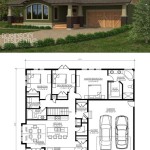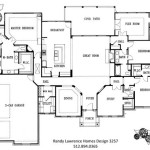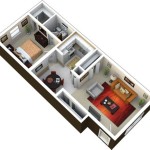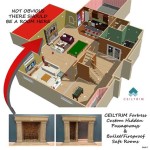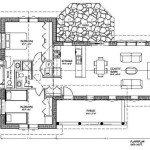Add-On House Plans, also known as house extensions or additions, are architectural designs specifically tailored to seamlessly integrate new living spaces into existing homes. These plans provide homeowners with a practical and cost-effective solution to expand their living areas without the need for constructing an entirely new dwelling. An example of an Add-On House Plan in action is the addition of a new master suite complete with a private bathroom and walk-in closet to a modest three-bedroom home.
The benefits of incorporating Add-On House Plans into residential properties are numerous. They allow homeowners to customize their living spaces to meet their evolving needs, whether it be accommodating a growing family, creating a home office, or transforming an existing space into a luxurious entertainment area. Moreover, these plans ensure that the new addition harmonizes seamlessly with the original architecture, preserving the home’s aesthetic integrity.
In the following sections, we will delve further into the intricacies of Add-On House Plans, exploring their different types, design considerations, and the construction process involved. We will also provide valuable tips and insights for homeowners contemplating adding an extension to their properties.
When considering Add-On House Plans, it is essential to keep several key points in mind:
- Define Your Needs: Clearly identify the purpose and scope of the addition.
- Architectural Harmony: Ensure the new addition complements the existing home’s style.
- Zoning Regulations: Verify compliance with local building codes and zoning restrictions.
- Construction Costs: Accurately estimate the financial implications of the project.
- Professional Design: Engage a qualified architect or designer to create detailed plans.
- Permits and Approvals: Secure necessary permits and approvals from local authorities.
- Contractor Selection: Choose a reputable contractor with experience in home additions.
- Construction Timeline: Establish a realistic timeline for the project’s completion.
- Future Value: Consider the potential impact of the addition on the home’s resale value.
By carefully considering these points, homeowners can make informed decisions and embark on successful Add-On House Plan projects.
Define Your Needs: Clearly identify the purpose and scope of the addition.
The foundation of a successful Add-On House Plan lies in clearly defining the purpose and scope of the addition. This involves carefully considering the reasons for expanding the home and the specific requirements that the new space must fulfill. Homeowners should ask themselves a series of questions to gain clarity on their needs:
- Increased Living Space: Is the addition intended to accommodate a growing family, provide more room for entertaining guests, or create a dedicated area for hobbies or work?
- Functional Requirements: What specific functions should the addition serve? For example, a new master suite may require a private bathroom and walk-in closet, while a home office may need built-in desks and ample storage.
- Lifestyle Considerations: How will the addition enhance the homeowner’s lifestyle? Will it provide a more comfortable and enjoyable living environment, or cater to specific interests or hobbies?
- Future Needs: Are there any anticipated changes in the household’s needs that the addition should accommodate? For instance, if children are expected in the future, it may be wise to include an additional bedroom or playroom in the plans.
By thoroughly defining their needs, homeowners can ensure that the Add-On House Plan is tailored to their specific requirements and aspirations, creating a living space that seamlessly integrates with their lifestyle and brings lasting satisfaction.
Once the purpose and scope of the addition have been carefully considered, homeowners can proceed to the next step of the planning process: assessing the existing home’s structure and architectural style to ensure that the new addition harmonizes with the overall design.
Architectural Harmony: Ensure the new addition complements the existing home’s style.
Maintaining architectural harmony between the existing home and the new addition is crucial for a cohesive and aesthetically pleasing result. This involves carefully considering the home’s existing architectural style, materials, and overall design to ensure that the addition seamlessly integrates and enhances the property’s visual appeal.
- Matching Architectural Style: The new addition should complement the architectural style of the existing home. For instance, if the home features a traditional Victorian design, the addition should incorporate similar design elements such as bay windows, intricate moldings, and a pitched roof.
- Material Harmony: The materials used in the addition should harmonize with those of the existing home. For example, if the home is constructed of brick, the addition should also utilize brick or a compatible material that blends seamlessly.
- Proportional Balance: The size and scale of the addition should be proportional to the existing home. An overly large or disproportionate addition can overwhelm the original structure and disrupt the overall aesthetic balance.
- Respecting Rooflines and Windows: The new addition should respect the existing rooflines and window placements of the home. Avoid blocking windows or creating awkward rooflines that disrupt the home’s visual flow.
By adhering to these principles of architectural harmony, homeowners can ensure that the new addition complements the existing home’s style, enhances its visual appeal, and creates a cohesive and inviting living space.
Zoning Regulations: Verify compliance with local building codes and zoning restrictions.
Zoning regulations are a crucial aspect of Add-On House Plans, as they establish the legal framework for construction and land use within specific areas. These regulations are implemented by local authorities to ensure orderly development, maintain property values, and protect the safety and well-being of residents.
Before embarking on an Add-On House Plan project, it is imperative to verify compliance with local building codes and zoning restrictions. Building codes specify the minimum construction standards that must be met to ensure the structural integrity and safety of the addition. Zoning restrictions, on the other hand, regulate the use of land and dictate factors such as the size, height, and placement of the addition.
To determine the applicable zoning regulations for a particular property, homeowners should contact their local planning department or building inspector. These authorities can provide detailed information on the specific requirements and restrictions that apply to the area. Failure to comply with zoning regulations can result in costly delays, fines, or even the requirement to demolish the unpermitted addition.
It is highly recommended to engage a qualified architect or contractor who is familiar with local building codes and zoning regulations. These professionals can guide homeowners through the permitting process, ensure that the plans meet all requirements, and help avoid any potential conflicts or delays.
Construction Costs: Accurately estimate the financial implications of the project.
Accurately estimating the construction costs associated with Add-On House Plans is essential for responsible financial planning and avoiding unexpected expenses. Several key factors influence the overall cost, and homeowners should carefully consider each to develop a realistic budget.
- Size and Complexity of the Addition: The size and complexity of the addition directly impact the cost of materials, labor, and permits. Larger additions with intricate designs and high-end finishes will naturally require a higher budget.
- Material Selection: The choice of materials for the addition, both interior and exterior, significantly influences the overall cost. Higher quality materials, such as natural stone, hardwood flooring, and energy-efficient windows, come with a premium price tag.
- Labor Costs: Labor costs vary depending on the region, availability of skilled contractors, and the complexity of the project. It is important to obtain quotes from multiple contractors to ensure competitive pricing.
- Permits and Inspections: Building permits and inspections are necessary to ensure compliance with local building codes and zoning regulations. These costs can vary depending on the size and scope of the project.
- Unexpected Expenses: It is wise to allocate a contingency fund for unexpected expenses that may arise during construction, such as unforeseen structural issues or weather-related delays.
To ensure an accurate cost estimate, homeowners should engage a qualified contractor or architect who can assess the specific requirements of the project and provide a detailed breakdown of the anticipated expenses. This will help avoid cost overruns and ensure that the project stays within the allocated budget.
Once the construction costs have been carefully estimated, homeowners can make informed decisions about the scope and scale of the addition. It may be necessary to adjust the plans or select more cost-effective materials to align with the available budget. By thoroughly considering the financial implications from the outset, homeowners can avoid financial strain and ensure that their Add-On House Plan project is completed successfully.
Professional Design: Engage a qualified architect or designer to create detailed plans.
Engaging a qualified architect or designer is crucial for successful Add-On House Plan projects. These professionals possess the expertise and experience to translate the homeowner’s vision into detailed and technically sound plans that comply with building codes and zoning regulations.
- Space Planning and Functionality: Architects and designers excel at space planning, ensuring that the new addition seamlessly integrates with the existing home’s layout and flow. They consider factors such as traffic patterns, natural light, and the functional needs of the homeowners.
- Structural Integrity and Safety: Qualified professionals have a deep understanding of structural engineering principles and can design additions that are both aesthetically pleasing and structurally sound. They ensure that the addition meets all applicable building codes and safety standards, providing homeowners with peace of mind.
- Architectural Expertise: Architects and designers possess a refined sense of aesthetics and can create additions that harmonize with the existing home’s architectural style. They can incorporate elements that complement the original design, enhancing the overall visual appeal of the property.
- Permitting and Approvals: A qualified architect or designer can guide homeowners through the often complex process of obtaining building permits and approvals from local authorities. Their expertise in navigating building codes and zoning regulations ensures a smooth and efficient permitting process.
By investing in professional design services, homeowners can benefit from expert guidance, detailed plans, and a higher likelihood of a successful Add-On House Plan project that meets their specific needs and enhances the value of their property.
Permits and Approvals: Secure necessary permits and approvals from local authorities.
Obtaining the necessary permits and approvals from local authorities is a crucial step in any Add-On House Plan project. These permits ensure that the addition complies with building codes, zoning regulations, and safety standards, safeguarding the structural integrity of the home and the well-being of its occupants.
The specific permits and approvals required vary depending on the jurisdiction and the scope of the project. However, some common permits include:
- Building Permit: This is the primary permit required for any structural changes or additions to a home. It authorizes the construction of the addition and ensures compliance with building codes, including safety regulations, energy efficiency standards, and accessibility requirements.
- Zoning Permit: This permit verifies that the addition adheres to local zoning regulations, which govern factors such as the size, height, setbacks, and use of the property. It ensures that the addition does not violate any zoning restrictions or negatively impact the neighborhood’s character.
- Electrical Permit: If the addition involves electrical work, a separate electrical permit is necessary. This permit ensures that the electrical installations meet safety standards and comply with building codes, minimizing the risk of electrical hazards.
- Plumbing Permit: Similarly, if the addition includes plumbing work, such as the installation of new fixtures or the extension of existing plumbing systems, a plumbing permit is required. This permit ensures that the plumbing work is performed according to code, preventing potential leaks or drainage issues.
To secure these permits and approvals, homeowners typically need to submit detailed plans of the addition, along with supporting documentation such as engineering calculations and energy efficiency reports. The local building department or planning commission will review the plans and conduct inspections throughout the construction process to ensure compliance.
Contractor Selection: Choose a reputable contractor with experience in home additions.
Selecting a reputable contractor is paramount for a successful Add-On House Plan project. An experienced and skilled contractor will ensure that the addition is constructed according to the plans, meets building codes and safety standards, and aligns with the homeowner’s vision. Here are key points to consider when choosing a contractor:
- Licensing and Insurance: Verify that the contractor holds a valid license and insurance, including liability and workers’ compensation coverage. This ensures that the contractor is legally authorized to perform the work and that homeowners are protected in case of accidents or damages.
- Experience and Expertise: Look for a contractor who has a proven track record in home additions and renovations. Experience in similar projects indicates that the contractor has the knowledge and skills to handle the specific requirements of an add-on project.
- References and Portfolio: Request references from previous clients and review the contractor’s portfolio of completed projects. This provides valuable insights into the contractor’s workmanship, attention to detail, and ability to meet client expectations.
- Communication and Transparency: Choose a contractor who is responsive, communicates clearly, and is about the project timeline, costs, and any potential challenges. Open and regular communication fosters trust and ensures that the homeowner is fully informed throughout the process.
By carefully considering these factors, homeowners can select a reputable contractor who will bring their Add-On House Plan vision to life, ensuring a high-quality addition that enhances the home’s functionality, value, and enjoyment.
Construction Timeline: Establish a realistic timeline for the project’s completion.
Establishing a realistic construction timeline is crucial for the successful execution of any Add-On House Plan project. A well-defined timeline provides a roadmap for the project, ensuring that all tasks are completed in a timely and coordinated manner.
To create a realistic timeline, homeowners should consider several key factors:
- Project Scope and Complexity: The size and complexity of the addition will significantly impact the construction timeline. Larger additions with intricate designs and specialized requirements will naturally require a longer construction period.
- Availability of Materials and Labor: The availability of materials and skilled labor can affect the timeline. Factors such as material lead times, weather conditions, and the availability of qualified contractors should be taken into account.
- Building Permits and Inspections: The time required to obtain building permits and conduct inspections can vary depending on the local jurisdiction and the scope of the project. It is important to factor in potential delays during the permitting process.
- Contingency Plan: It is prudent to include a contingency period in the timeline to accommodate unexpected delays or unforeseen circumstances that may arise during construction.
By carefully considering these factors, homeowners can establish a realistic construction timeline that allows for efficient project execution, minimizes disruptions, and ensures that the addition is completed to a high standard of quality.
Once a realistic timeline has been established, it is important to communicate it clearly to all parties involved in the project, including the contractor, subcontractors, and homeowners. Regular progress monitoring and communication are essential to ensure that the project stays on track and any potential delays are identified and addressed promptly.
Sticking to the construction timeline requires careful coordination and proactive management. Homeowners should be actively involved in the project, attending regular progress meetings, reviewing project updates, and promptly addressing any issues that may arise. By adhering to the timeline and managing the project effectively, homeowners can minimize delays, control costs, and ensure the timely completion of their Add-On House Plan project.
A well-defined and realistic construction timeline is a cornerstone of any successful Add-On House Plan project. It provides a clear roadmap for project execution, minimizes disruptions, and ensures that the addition is completed to the homeowner’s satisfaction, enhancing the functionality, value, and enjoyment of their home.
Future Value: Consider the potential impact of the addition on the home’s resale value.
When planning an Add-On House Plan project, it is essential to consider the potential impact of the addition on the home’s resale value. A well-conceived and executed addition can significantly increase the home’s value, providing a return on investment when it comes time to sell. Here are key points to keep in mind:
- Increased Living Space: An addition that increases the home’s living space, such as adding a bedroom or expanding the kitchen, can make the home more attractive to potential buyers and increase its market value.
- Enhanced Functionality: Additions that improve the functionality of the home, such as adding a home office or a mudroom, can also increase its value. These features cater to modern living needs and make the home more appealing to a wider range of buyers.
- Architectural Harmony: An addition that seamlessly integrates with the existing home’s architectural style and design can enhance the overall aesthetic appeal of the property. This can positively impact the home’s curb appeal and value.
- Energy Efficiency: An addition that incorporates energy-efficient features, such as high-performance windows and insulation, can reduce the home’s operating costs and make it more attractive to environmentally conscious buyers. Energy-efficient homes are increasingly sought after and command higher prices.
It is important to note that not all additions will increase the home’s value equally. Poorly planned or executed additions can actually decrease the home’s value. Homeowners should carefully consider the design, functionality, and quality of the addition to ensure that it complements the existing home and meets the needs of potential buyers.
To maximize the impact of an addition on the home’s resale value, homeowners should consult with a qualified architect or designer who can help them create a plan that optimizes the addition’s value and ensures that it aligns with the home’s overall design and functionality. Additionally, homeowners should obtain professional appraisals before and after the addition to accurately assess the impact on the home’s value.
By carefully considering the potential impact of an Add-On House Plan project on the home’s resale value, homeowners can make informed decisions that will enhance the value of their property and provide a solid return on their investment.
Remember, the value of a home is determined by a combination of factors, including its location, condition, size, and amenities. An addition that thoughtfully addresses these factors can significantly increase the home’s value and make it more desirable to potential buyers.










Related Posts


